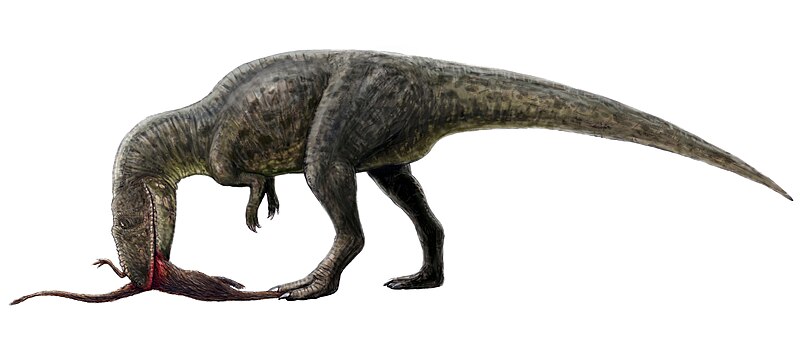Post by dinosauria101 on Jul 12, 2019 16:15:14 GMT 5
Dakotaraptor steini
Dakotaraptor is a genus of large carnivorous dromaeosaurid theropod from the Late Cretaceous of North America. The first fossils of Dakotaraptor were found in South Dakota, United States, in 2005. In 2015, the genus Dakotaraptor received its name, meaning "plunderer of Dakota", when the type species Dakotaraptor steini was described. The fossils contain an incomplete skeleton without a skull and some individual bones. They have been found in the Maastrichtian-age Hell Creek Formation, dated to the very end of the Cretaceous period, making Dakotaraptor one of the last surviving dromaeosaurids. It had long arms with one of the lower arm bones showing quill knobs, demonstrating that it was most likely feathered. It also had long rear legs with a very large sickle claw on the second toe; this claw could be used to kill relatively large plant-eating dinosaurs. It lived in the same time and area as many iconic late Cretaceous dinosaurs such as Ankylosaurus, Triceratops, and Tyrannosaurus. Dakotaraptor is exceptionally large for a dromaeosaurid; it has an estimated adult length of 5.5 m (18 ft) and a weight of 250-450 kilograms (550-1000 pounds).This approaches the size of the largest known dromaeosaurid, Utahraptor. Dakotaraptor however, does not have the proportions and adaptations of Utahraptor, but more closely resembles smaller dromaeosaurids like Deinonychus.

Shaochilong maortuensis
Shaochilong (meaning "shark toothed dragon") is a genus of carcharodontosaurid dinosaur from the mid Cretaceous (Turonian stage) Ulansuhai Formation of China (about 92 million years ago). The type species, S. maortuensis, was originally named Chilantaisaurus maortuensis, but was re-described and reclassified in 2009. The holotype, IVPP V2885.1-7, consisting of skull fragments, axis and six caudal vertebrae associated to a single individual is the only known specimen. This specimen was discovered in Outer Mongolia and described by Hu in 1964 as a species of Chilantaisaurus. Chure (2002) and Rauhut (2001) suggested that it did not belong to that genus, and was probably a primitive coelurosaur. However, a re-description by Brusatte and colleagues in 2009 found that it was in fact a carcharodontosaurid, the first recognized from Asia. The genus was originally informally named "Alashansaurus". IVPP V2885.1 was probably adult or nearly adult individual. Its length – based on the length of the maxillary tooth row – is estimated at 6 metres (20 ft). Estimated length of the femur is 61.5 cm, what suggests that whole animal weighted approximately 500 kilograms (1,100 lb).

Credit to Wikipedia
Dakotaraptor is a genus of large carnivorous dromaeosaurid theropod from the Late Cretaceous of North America. The first fossils of Dakotaraptor were found in South Dakota, United States, in 2005. In 2015, the genus Dakotaraptor received its name, meaning "plunderer of Dakota", when the type species Dakotaraptor steini was described. The fossils contain an incomplete skeleton without a skull and some individual bones. They have been found in the Maastrichtian-age Hell Creek Formation, dated to the very end of the Cretaceous period, making Dakotaraptor one of the last surviving dromaeosaurids. It had long arms with one of the lower arm bones showing quill knobs, demonstrating that it was most likely feathered. It also had long rear legs with a very large sickle claw on the second toe; this claw could be used to kill relatively large plant-eating dinosaurs. It lived in the same time and area as many iconic late Cretaceous dinosaurs such as Ankylosaurus, Triceratops, and Tyrannosaurus. Dakotaraptor is exceptionally large for a dromaeosaurid; it has an estimated adult length of 5.5 m (18 ft) and a weight of 250-450 kilograms (550-1000 pounds).This approaches the size of the largest known dromaeosaurid, Utahraptor. Dakotaraptor however, does not have the proportions and adaptations of Utahraptor, but more closely resembles smaller dromaeosaurids like Deinonychus.

Shaochilong maortuensis
Shaochilong (meaning "shark toothed dragon") is a genus of carcharodontosaurid dinosaur from the mid Cretaceous (Turonian stage) Ulansuhai Formation of China (about 92 million years ago). The type species, S. maortuensis, was originally named Chilantaisaurus maortuensis, but was re-described and reclassified in 2009. The holotype, IVPP V2885.1-7, consisting of skull fragments, axis and six caudal vertebrae associated to a single individual is the only known specimen. This specimen was discovered in Outer Mongolia and described by Hu in 1964 as a species of Chilantaisaurus. Chure (2002) and Rauhut (2001) suggested that it did not belong to that genus, and was probably a primitive coelurosaur. However, a re-description by Brusatte and colleagues in 2009 found that it was in fact a carcharodontosaurid, the first recognized from Asia. The genus was originally informally named "Alashansaurus". IVPP V2885.1 was probably adult or nearly adult individual. Its length – based on the length of the maxillary tooth row – is estimated at 6 metres (20 ft). Estimated length of the femur is 61.5 cm, what suggests that whole animal weighted approximately 500 kilograms (1,100 lb).

Credit to Wikipedia









